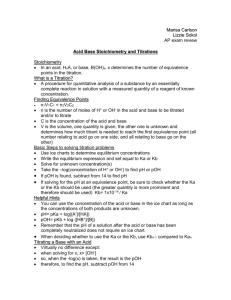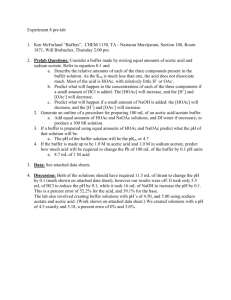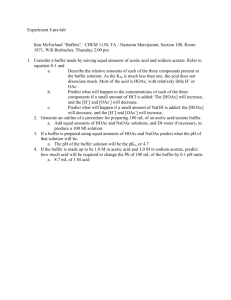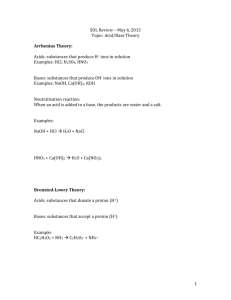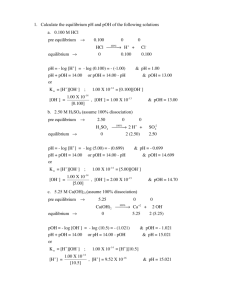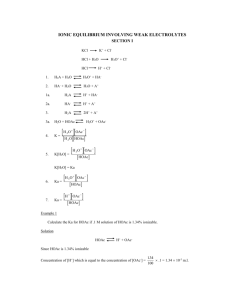Chapter 16. Aqueous Ionic Equilibria
advertisement
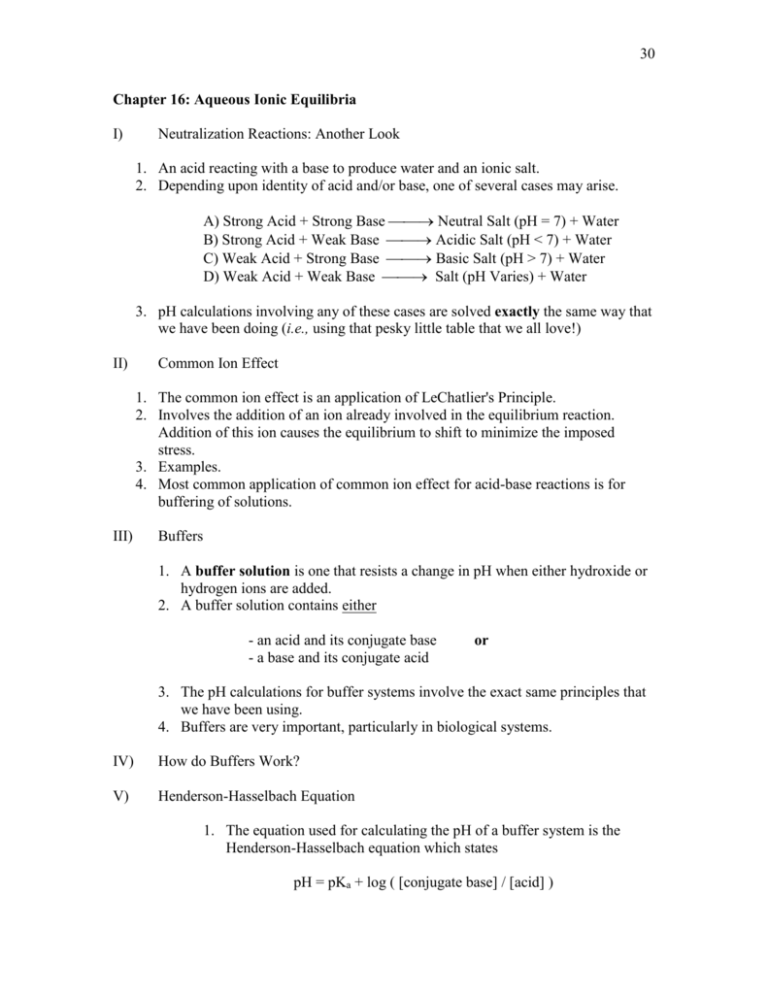
30 Chapter 16: Aqueous Ionic Equilibria I) Neutralization Reactions: Another Look 1. An acid reacting with a base to produce water and an ionic salt. 2. Depending upon identity of acid and/or base, one of several cases may arise. A) Strong Acid + Strong Base Neutral Salt (pH = 7) + Water B) Strong Acid + Weak Base Acidic Salt (pH < 7) + Water C) Weak Acid + Strong Base Basic Salt (pH > 7) + Water D) Weak Acid + Weak Base Salt (pH Varies) + Water 3. pH calculations involving any of these cases are solved exactly the same way that we have been doing (i.e., using that pesky little table that we all love!) II) Common Ion Effect 1. The common ion effect is an application of LeChatlier's Principle. 2. Involves the addition of an ion already involved in the equilibrium reaction. Addition of this ion causes the equilibrium to shift to minimize the imposed stress. 3. Examples. 4. Most common application of common ion effect for acid-base reactions is for buffering of solutions. III) Buffers 1. A buffer solution is one that resists a change in pH when either hydroxide or hydrogen ions are added. 2. A buffer solution contains either - an acid and its conjugate base - a base and its conjugate acid or 3. The pH calculations for buffer systems involve the exact same principles that we have been using. 4. Buffers are very important, particularly in biological systems. IV) How do Buffers Work? V) Henderson-Hasselbach Equation 1. The equation used for calculating the pH of a buffer system is the Henderson-Hasselbach equation which states pH = pKa + log ( [conjugate base] / [acid] ) 31 2. Some example calculations. VI) Buffer Capacity 1. Represents the amount of protons or hydroxide ions the buffer can absorb without a significant change in pH. 2. The pH of a buffered solution is determined by the ratio [conjugate base] / [acid]. The capacity of a buffer is determined by the magnitude of [conjugate base] & [acid]. 3. Review Example Problems VII) Titrations & pH Curves 1. Plot of pH as a function of volume of titrant added. 2. Titrant can be an acid or base and is simply a solution whose concentration is accurately known. 3. Common Characteristics of Titration Curves - - - Millimole (mmol) is a common unit in solving titration problems. It functions in same way as the mole does; but it is simply smaller. Equivalence point - point in titration where acid neutralizes base or base neutralizes the acid. For a strong acid / strong base system the equivalence point pH is always 7.00. For a weak acid / strong base system the equivalence point pH will be above 7.00 For a weak base / strong acid system the equivalence point pH will be below 7.00 Use acid-base indicators to denote end point (equivalence pH) 4. Titration Equations [H+] = (no. mmoles initially present – no. mmoles reacted ) total volume (mL) 5. Examples 40.00 mL 0.250M NaOH 0.250M HCl Calculate pH after 0.00 mL, 5.00 mL, 15.00 mL, 20.00 mL, 30.00 mL, & 40.00 mL HCl added to base 32 Initial pH 0.00 mL HCl added [OH-] = 0.250M pOH = -log [OH-] 0.00 mL HCl [OH-] = 0.250 M pOH = 0.60 pH = 13.40 5.00 mL HCl [OH-] = 0.194 M pOH = 0.71 pH = 13.29 15.00 mL HCl [OH-] = 0.114 M pOH = 0.94 pH = 13.06 20.00 mL HCl [OH-] = 0.0833 M pOH = 1.08 pH = 12.92 30.00 mL HCl [OH-] = 0.036 M pOH = 1.45 pH = 12.55 40.00 mL HCl (equivalence point) [OH-] = 1.00x 10-7 M pOH = 7.00 Practice Problem 50.00 mL 0.200M HCl 0.100M NaOH pH = 7.00 use same volumes 33 6. Yet another example 40.00 mL Initial pH 0.100 M Acetic Acid 0.100 M NaOH Acetic Acid is a weak acid so we must use Ka value; HoAc + HOH H3O+ + oAc0.00 mL NaOH Ka = 1.8 x 10-5 = x2 / (0.100 – x) x = [H3O+] = 1.34 x 10-3 M pH = 2.87 The assumption ( x << 0.100 M) is valid by the 5% rule. 5.00 mL NaOH As one begins to add base, a buffer solution results. The principal equation in this titration is our old friend HoAc + HOH H3O+ + oAc- Ka = 1.8 x 10-5 We simply must find [oAc-] and [HoAc] and then plug and chug using HendersonHasselbach equation. Therefore, 5.00 mL NaOH [oAc-] = 0.011M [HoAc] = 0.077 M pH = 3.89 10.00 mL NaOH [oAc-] = 0.020M [HoAc] = 0.080 M pH = 4.14 20.00 mL NaOH [oAc-] = 0.033M [HoAc] = 0.033 M pH = 4.74 Notice that at 20.00 mL NaOH added, the concentrations of both [oAc-] and [HoAc] are equal to one another. When this happens you are at the half equivalence point so named because half of the acid has been neutralized by the base. At the half equivalence point the pH is equal to the pKa of the acid. Using the Henderson-Hasselbach equation, verify that the above statement is true. 30.00 mL NaOH [oAc-] = 0.043 M [HoAc] = 0.14 M pH = 5.22 35.00 mL NaOH [oAc-] = 0.047M [HoAc] = 0.0067 M pH = 5.59 40.00 mL NaOH Once we reach the equivalence point, all of the [HoAc] has reacted, so the principal reaction now involves the acid salt (sodium acetate) reacting with water. Ignoring the spectator ion (sodium) we can represent the reaction as follows: 34 oAc- + HOH HoAc + OH- 0.05 M -x 0.05 – x 0.00 M x x Kb = Kw / Ka = 1.00 x 10-14 / 1.8 x 10-5 Kb = 5.55 x 10-10 0.00 M x x Solving the following expression gives us [OH-] Kb = 5.55 x 10-10 = x2 / (0.05 – x) The [OH-] is 5.27 x 10-6 M (x << 0.05M so assumption is valid); therefore, pOH =5.28. Using pH + pOH = 14.00 one obtains a pH value of 8.72. The pH value is above 7.00 which is consistent since the base is stronger than the acid. Beyond equivalence point Here the [OH-] from excess NaOH is the overriding factor; therefore, the pH rises very rapidly as would be expected for a strong base. 7. Polyprotic Acids & Bases follow the same principles as previously shown. VII) Solubility Equilibria 1. Solubility equilibrium position 2. Solubility product equilibrium constant (Ksp) Example: CaF2 (s) Ca2+ + 2 F - Ksp = [Ca2+][ F -]2 4. Table 16.2 & Appendix II (C-4) 5. Common Ion , pH Effects, and Solubility Effects 6. Ion Product

